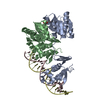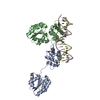+Search query
-Structure paper
| Title | Structural basis of DNA recognition of the CosR regulator. |
|---|---|
| Journal, issue, pages | mBio, Vol. 15, Issue 3, Page e0343023, Year 2024 |
| Publish date | Mar 13, 2024 |
 Authors Authors | Zhemin Zhang / Yuqi Yan / Jinji Pang / Lei Dai / Qijing Zhang / Edward W Yu /  |
| PubMed Abstract | is a foodborne pathogen commonly found in the intestinal tracts of animals. This pathogen is a leading cause of gastroenteritis in humans. Besides its highly infectious nature, is increasingly ... is a foodborne pathogen commonly found in the intestinal tracts of animals. This pathogen is a leading cause of gastroenteritis in humans. Besides its highly infectious nature, is increasingly resistant to a number of clinically administrated antibiotics. As a consequence, the Centers for Disease Control and Prevention has designated antibiotic-resistant as a serious antibiotic resistance threat in the United States. The CosR regulator is essential to the viability of this bacterium and is responsible for regulating the expression of a number of oxidative stress defense enzymes. Importantly, it also modulates the expression of the CmeABC multidrug efflux system, the most predominant and clinically important system in that mediates resistance to multiple antimicrobials. Here, we report structures of apo-CosR and CosR bound with a 21 bp DNA sequence located at the promotor region using both single-particle cryo-electron microscopy and X-ray crystallography. These structures allow us to propose a novel mechanism for CosR regulation that involves a long-distance conformational coupling and rearrangement of the secondary structural elements of the regulator to bind target DNA. IMPORTANCE: has emerged as an antibiotic-resistant threat worldwide. CosR is an essential regulator for this bacterium and is important for adaptation to various stresses. Here, we describe the structural basis of CosR binding to target DNA as determined by cryo-electron microscopy and X-ray crystallography. Since CosR is a potential target for intervention, our studies may facilitate the development of novel therapeutics to combat infection. |
 External links External links |  mBio / mBio /  PubMed:38323832 / PubMed:38323832 /  PubMed Central PubMed Central |
| Methods | EM (single particle) / X-ray diffraction |
| Resolution | 2.21 - 3.77 Å |
| Structure data | EMDB-42602, PDB-8uuz:  PDB-8uvk:  PDB-8uvx: |
| Chemicals |  ChemComp-PEG:  ChemComp-HOH: |
| Source |
|
 Keywords Keywords | DNA BINDING PROTEIN / Campylobacter jejuni / CosR / transcriptional regulator / DNA BINDING PROTEIN/DNA / DNA BINDING PROTEIN-DNA complex |
 Movie
Movie Controller
Controller Structure viewers
Structure viewers About Yorodumi Papers
About Yorodumi Papers






